Whether you’re treating yourself to your first real high-end acoustic guitar or you’re a seasoned working musician looking for an upgrade, guitar shopping with a budget of $2,000 leaves you with tons of fantastic options.
We put together this KillerGuitarRigs Review of the Best Acoustic Guitars Under $2,000 to show you some of the fantastic options you have at this price range. We’ve included models starting at $1,000 all the way to the top end of the budget, focusing on appearance, quality, playability, and tone. When covering acoustic electric models, we used the acoustic voice on our Boss Katana Head and Katana cabinet, with the same settings for every guitar.
If you’re looking for inspiration, or you’re not even sure where to start looking for your next acoustic, you won’t want to miss this. Keep on reading to learn more.
Read more about our review process.

Martin D-16E Rosewood
Features: Solid spruce top, Solid rosewood back/sides, Dreadnought body
Benefits: Pro grade playability, Exceptional tonal balance, Excellent residual value
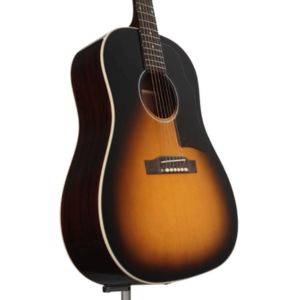
Epiphone Slash J-45
Features: LR Baggs electronics, Solid Sitka spruce top, Grover tuners
Benefits: Easy amplification, Great balance, Fast playing neck
Contents
Our Top 3
We loved the blend of performance and value for money we got in the Taylor American Dream AD17. So much so, that it took our Top Pick award. It was tons of fun to play, and sounded wonderful.
Our Best Value choice went to the Epiphone Slash J-45. Considering it costs just half of the allotted budget, it delivers big across the board, matching much more expensive competition in terms of materials, construction quality, and tone.
Shoppers who aren’t afraid to go all in with their budget to get the very best guitar in the price range should be looking at our Editor’s Choice, the Martin D-16E. It offers some of the sweetest most nuanced tones you’ll hear at any price and delivers unparalleled playability.
Individual Reviews
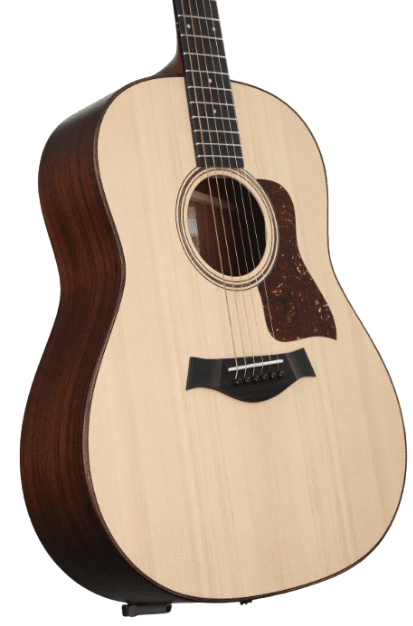
Taylor American Dream AD17
An affordable entry point into a US made Taylor.
This is a wonderful guitar for players looking for plenty of bn for their buck. It’s an American made model, constructed with all solid woods, and it delivers big on the bright, room filing tones that Taylor is so well known for.
The Taylor American Dream AD17 had an extremely handsome slope-shoulder dreadnought body style, which Taylor refer to as the “Grand Pacific” body design.
It was made with a spruce top and ovangkol back and sides. Interestingly, Taylor has placed more emphasis on tone and dynamics than aesthetics on the American Dream series, with the intent of producing a better-sounding guitar at a more affordable price. Honestly, we think they absolutely nailed it.
The neck was made from mahogany and like most Taylor necks, it was very slim and extremely comfortable. More like an electric guitar‘s neck than you’d typically find on an acoustic guitar. Topping the neck was a eucalyptus wood fretboard. This fretboard had the dark luster of ebony, but with the benefit of being a much more sustainable material.
We were seriously impressed with the fret work on this model. It was about as nicely dressed as we’ve ever seen a non-PLEKd guitar, with beautiful rounded edges and smooth, level crowns.
As for tones, the American dream was clean and exceptionally bright. Even though it was bright, it’s still had quite a mature tone which we attributed to the choice of wood used in the body construction. It was punchy and articulate, especially around the midrange, and had a well-tamed top end that gave us plenty of shimmer without sounding brittle or harsh.
The hardware was as good as you’d expect for a guitar at this price point. It had Taylor-branded tuning machines which performed flawlessly, providing rock-solid tuning stability and easy fine-tuning.
Verdict: The Taylor American Dream AD17 was a real joy to play. The set up out of the box was absolutely superb, and we’d have no issue taking this directly to a gig or to the studio without any adjustments. As an added bonus, it came with a fantastic Taylor AeroCase gig bag.
- Superb fretwork
- Bright tones
- Comfortable body
- Ovangkol fretboard
- Less attractive grain
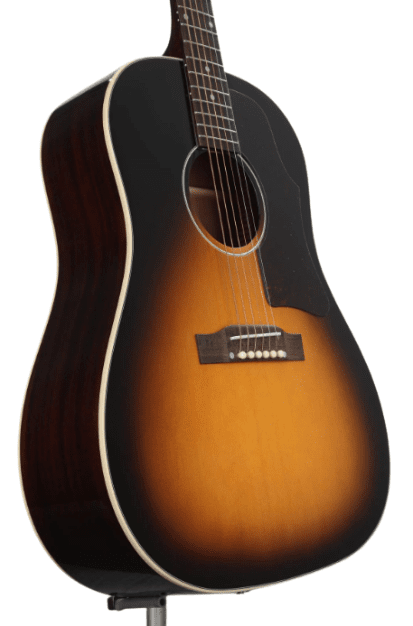
Epiphone Slash J45
A phenomenally well made and equipped signature model guitar.
This model sits at the upper end of Epiphone’s range. It has a classic Gibson style J 45 slope shoulder design, developed in conjunction with the signature artist himself, none other than Slash. It benefits from all solid wood construction, and has one of the nicest finishes you’ll see on any acoustic guitar.
Being one of the flagship models, the Epiphone Slash J-45 was made with all solid woods. Sitka spruce on the top and solid mahogany on the back and sides. This is an obvious step up from most Epiphones. Those with reservations about spending $1,000 on an imported guitar can rest assured this is made as well as any domestic model.
It had a mahogany neck with Epiphone’s excellent C profile. It felt fantastic, it was fast-playing, extremely forgiving, and very comfortable even during extended use. As per slushes specifications, it has a 16-inch radius making the Indian Laurel fretboard better than average for easy rhythm work and fatigue-free lead playing.
Tones from this guitar were absolutely exceptional. It was punchy and it had an undeniably strong midrange presence. The bottom end was huge, giving it awesome resonance and some beautifully subtle overtones that manage to reach all corners of any room you play in.
It was equipped with a fantastic LR Baggs VTC pickup system. This is one of our absolute favorite acoustic electronic sets! It served up some fantastic organic, natural acoustic tones, and was very responsive to changes in attack. It was also nice to see a discrete sound-hole volume control.
Overall build quality was Excellent. Epiphone have fitted the Slash signature with some high-end hardware including Grover Rotomatic tuners. They delivered reliable tuning performance and added to the premium aesthetic. We were also very pleased to see that it came with a Slash-branded fitted hard case.
Verdict: The Epiphone Slash J-45 delivered an incredibly rewarding playing experience. While many now associate the Epiphone brand with budget guitars, this is anything but budget. It offers professional-level playability and tones, comes in well under the $2,000 budget, and looks fantastic in the process.
- All solid wood
- Available in 2 awesome finishes
- Premium feel
- Indonesian made
- Slash branding might not appeal
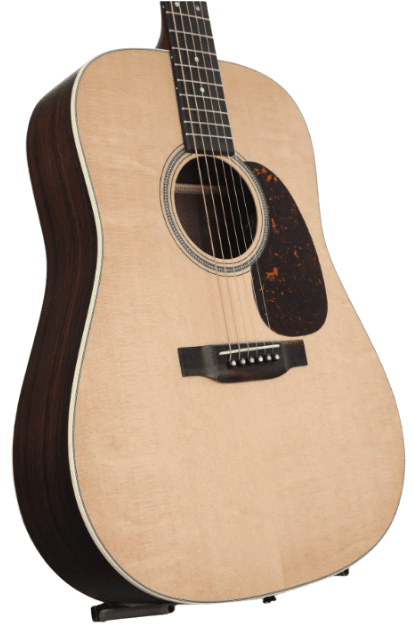
Martin D-16E
Iconic tones, timeless looks, and stellar performance.
This dreadnought comes from the original inventor of the style, and it really shows. It delivers huge tones that remain composed in any situation, and because it’s hand crafted by some of the world’s finest luthiers a Martin’s Nazareth, PA plant, it’s an heirloom quality instrument that’s truly built to last.
When it comes to construction materials, this brand is widely known to select some of the finest woods for use in the premium models such as the Martin D-16E (full review here). It came with a fantastic Sitka spruce top, and even genuine rosewood back and sides. Being made with all solid woods gave this guitar such incredible presence and wonderful character.
The neck was carved into a modified low-oval profile. This is similar to a slim D Shape. It was supremely comfortable and this was no doubt aided by the use of a performing artists taper on the neck that allowed for exceptional fret access up and down the entirety of the neck.
Because the D-16E has a slightly slimmer body than a standard Martin dreadnought, the bass was ever so slightly reduced, which made this the perfect recording guitar. Despite the reduced bass, it still retained enormous presence with prominent mids and a gorgeous shimmery top end. Playing an open chord on this guitar and just letting it ring instantly put a smile on the face of anybody who heard it – simply incredible.
For those who like to play through an amplifier, it was equipped with a Fishman Matrix VT Enhance NT2 pickup system. In addition to the traditional under-saddle piezo transducer, it included an advanced Enhance element that was able to be blended into the piezo output, giving a whole new range of organic tones.
One of the things we love most about high-end Martins is the use of beautiful open-gear tuning machines. Not only did the tuners on this Martin look fantastic, but they also performed brilliantly and they worked well with the genuine bone nut to deliver perfect intonation and incredible tuning stability. As expected of any good guitar at this price point, it did come with a nice quality gig bag.
Verdict: The Martin D-16E is simply the best acoustic guitar on the market for $2,000 or less. The craftsmanship is simply unparalleled and the tones are instantly recognizable. Don’t forget that this is no show pony either! While it would look fabulous hanging on a wall, it would look even better onstage or in the studio with any artist, amateur or professional.
- PLEKd frets
- Beautiful woods
- Excellent electronics
- Expensive
- Quieter than full depth dreadnoughts
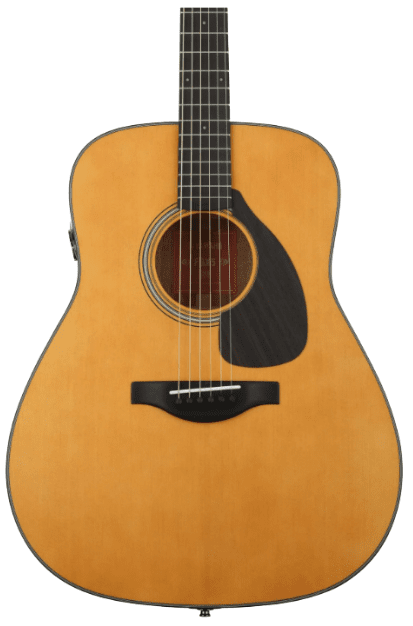
Yamaha Red Label FGX5
A Japanese legend reborn for today’s player.
This guitar is a true Japanese icon. This particular guitar is a reboot of the classic red label models of the 1960s and is a glowing example of the type of quality that Yamaha is renowned for. It’s made with such incredible attention to detail you’ll find yourself questioning why it’s not a more popular model.
The construction of the Yamaha Red Label FGX5 is all solid wood, with spruce being used for the top, and solid mahogany for the back and sides. One thing we weren’t too fond of was the aging tint applied to the top. It detracted from the bright aesthetic of the spruce, making it look more like a classical model.
On this model, Yamaha has used their A.R.E. wood torrefaction, which simply means they artificially aged the wood to give the guitar a mature, broken-in tone right out of the box.
It had a solid African mahogany neck carved into a medium to slim-sized C profile. We found it to be very comfortable from top to bottom and quite fast playing, too. Continuing the theme of premium woods, it featured a stunning ebony fretboard, which looked amazing and really added to the already excellent playability.
As we’ve found with almost every Yamaha we’ve ever tested, the fretwork was extremely well done. Of course, being a flagship model, the frets were a significant step above Yamaha‘s regular models. They were incredibly smooth on top and had perfectly beveled edges, further increasing the comfort of this guitar.
Tonally, the FGX5 was very nicely balanced. The Sitka spruce top delivered some excellent sparkle around the mids and top end, and the full-size dreadnought-style body provided incredible projection and room-filling volume. The A.R.E.-treated wood made a lot of difference, giving it a real vintage tone right out of the box.
We were big fans of the Yamaha Atmosfeel electronic setup. It came with a pickup and a preamp, with a piezo under-saddle transducer and an internal microphone. Having a transducer and microphone working together in tandem delivered some incredible tones and really captured the essence of the FGX5’s character.
It had a blend knob that allowed us to fade between the pickup and the mic, a very welcome feature. Unfortunately, the knobs were quite low-profile, which did make them difficult to adjust the players with big hands.
Yamaha really did a great job curating the hardware for this guitar. It came with a bone nut and a bone saddle, a custom-fit hard case, and a set of gorgeous Gotoh open-gear tuning machines, which looked as good as they performed.
Verdict: The Yamaha Red Label FGX5 really does showcase all that Yamaha are capable of. It was a master class in construction quality and the tones were simply outstanding. It was let down a little by the controls for the electronics, but this is a fairly insignificant complaint in the context of how good this guitar is as a whole.
- Quality components
- Exceptional fit and finish
- Real vintage tones
- Tinted top
- EQ knobs hard to manipulate
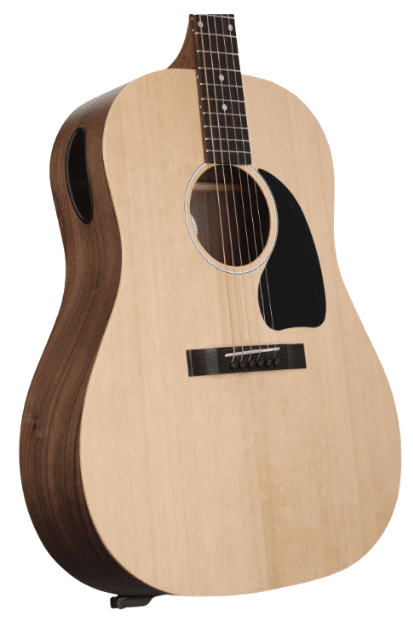
Gibson G-45
A stripped down version of an American icon.
With this acoustic guitar, you’re getting a fantastic US made instrument from one of the most established names in Lutherie. This model takes things back to basics using simple, yet quality materials to create a guitar that delivers the unmistakable Gibson tone at a price that might surprise you.
Like all Gibson Guitars, the Gibson G-45 (full review here) is proudly hand-made in Bozeman, Montana. Intentionally light on embellishments, the prime goal of the G-45 is to deliver Gibson tone at an attainable price.
It had Gibson’s legendary slope-shoulder dreadnought body shape, which has always been a favorite of ours at KGR. The top was made with solid Sitka spruce, while the back and sides were crafted from walnut. It had a very thin satin nitro lacquer, so with time will check and age naturally.
The neck was made from utile, and had Gibson’s advanced response profile. The AR profile is a little thicker than the slim taper D and in truth, we did find ourselves wishing it had the slim tip of the neck. The thicker profile was still comfortable, but it noticeably slowed down our playing.
For what’s supposed to be a no-frills model, we were pleased to see a striped ebony fretboard. The dark wood really looked great and felt good under the fingers.
We found out the tones from the G-45 were punchy and very responsive to change in attack. It had a very prominent midrange and a deep, booming bottom end, but not a lot of emphasis on the troubles. This led to it sounding a little muddy when played hard.
One other interesting feature was the Player Port, which is a secondary sound hole in the upper bass side bout, designed to let the player hear a more accurate representation of the guitar’s real sound. We loved the concept, but in reality, we didn’t find it made all that much difference.
For hardware, it was equipped with Grover Rotomatic tuners and a Tusq nut and saddle. Tuning stability was excellent, the guitar was perfectly intonated, and the setup was good to go right out of the box.
Verdict: The Gibson G-45 is a great entry point into full-size Gibson acoustics. We think that this model is absolutely suitable for amateurs and working musicians alike, and we think it would be best suited to rhythm players, due to its strong mid and bass performance.
- US Made
- Nitro finish
- Grover tuners
- Neck was a little thick
- Player port felt gimmicky
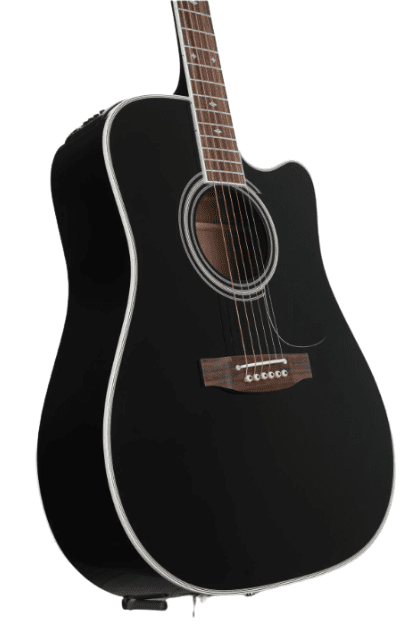
Takamine Legacy EF341SC
This hand crafted guitar is a favorite of Bruce Springsteen, and for good reason.
Any player looking for something a little different should give a lot of consideration to this guitar. Its black finish is simply stunning, it offers fantastic acoustic and amplified performance, and to top things off, it’s built to the highest standards, by true artisans.
The Takamine Legacy EF341SC is a highly sought after Japanese made model, that serves up bold looks and even bolder performance.
It had a dreadnought-style body with a single cut away, providing excellent upper fret access. The top was made with solid cedar and the back and sides were made from solid maple. This combination of tonewoods gave the Takamine Legacy a fantastically unique sound profile.
The gloss body finish continued up onto the Mahogany neck, which was disappointing to say the least. While it honestly looked amazing, a satin finish for the neck would’ve been much preferred for playability.
Thankfully, the rosewood fretboard and the high quality fretwork somewhat made up for the sticky neck. The edges were perfectly finished and the crowns were smooth as glass.
Tones were another strong point for the Legacy. This was the only cedar-topped model in the roundup and it really did sound like nothing else. The top end was warm and delicate, and the maple back and sides gave it plenty of punch to deliver tight, room-filling bass that never overpowered the rest of the mix.
For those who like to play amplified, it featured proprietary Takamine electronics, which performed well, giving an accurate representation of the guitar’s tone across a range of volumes. Sadly, the graphic EQ controls looked very dated and spoiled the otherwise sleek look of the guitar.
Overall build quality was exceptional, as evidenced by the stunning paintwork and the inclusion of high-end components like Gotoh tuners and bone for the saddle and nut.
Verdict: The Takamine Legacy EF341SC was a glowing example of why Takamine guitars have been favorites among professional musicians at the highest level for decades. It was clearly built by extremely skilled luthiers and this showed in all areas including the build quality and the gorgeous tones.
- Exceptional hand built quality
- Unique tones
- Excellent upper fret access
- Gloss neck finish
- Unattractive EQ controls
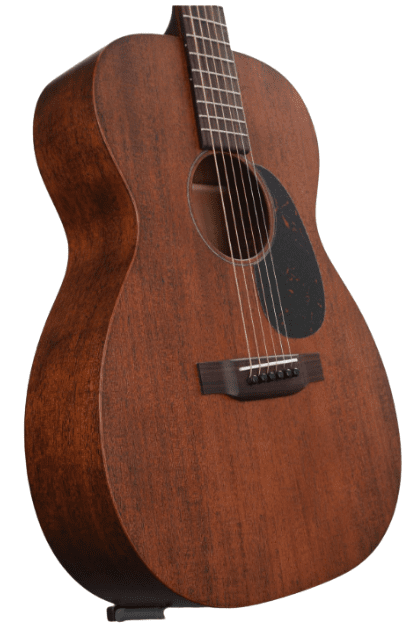
Martin 00–15M
A simple strummer that takes things back to Martin’s roots.
This Martin is a Blues players Dream. It’s a real performer that doesn’t rely on fancy trim or embellishments, it simply lets the tones do the talking. It’s an all solid wood, US made Martin, and it could be yours with change to spare.
The Martin 00–15M Was the smallest guitar in this roundup by quite some margin. What it locked in size, it did make up for in character. As you can probably guess by its name, it had 00 body style, similar in size to a concert guitar.
Mahogany was the primary construction material in this case, with solid mahogany being used for the top, back, and sides, as well as the neck. While we appreciated the simplicity of the guitar, the thin top coat did make the surface look and feel somewhat unfinished, which may not be to everyone’s taste.
We found the neck to be comfortable, and this was no surprise given it had the same modified low-oval profile as our Editor’s Choice, the Martin D-16E. Rosewood was used for the fretboard, and while it didn’t have binding or any aesthetic flourishes to speak of, the edges were exceptionally comfortable with good economics. It also helped that the fretwork was immaculate.
Blues players will absolutely love the tones from this Martin. We found they were perfect for Delta blues fingerpicking. It had strong presence around the trebles and upper middle, which made it really pop in a mix. It had great articulation and note separation, too.
This guitar was clearly built to a high standard using quality components. It was perfectly set up from the factory with amazing playability and rock-solid tuning stability.
Verdict: The Martin 00-15M might not be the prettiest guitar, but it’s reliable and will age wonderfully with time. It served up some fantastic tones that really helped us to find the joy in simplicity, getting back to basics without the distractions that many expensive guitars offer.
- Wonderful tone
- Reliable performance
- Tons of character
- Unfinished feel
- Small bass response
How to Choose the Right Guitar For You
While shopping for guitars at this price point means you’re unlikely to end up with a lemon, the hunt isn’t without potential pitfalls. In order to ensure you get a great guitar that suits your needs, we’ve put together this buyer’s guide to help you navigate through your options.
Materials
The first thing you need to consider is what the body of the guitar is made from. This has the biggest impact on tone by quite some margin and it will likely have the biggest impact on the price, too.
Solid Wood vs. Laminate
Laminates have come a long way and still have their place in guitar construction, but when looking at models that cost up to $2,000, you’ll want to make sure you’re looking at guitars that make use of all solid woods (including the back, sides, and neck). Solid woods tend to produce better resonance and sustain than laminates, and they’ll generally look better, too.
Body Style
There are a number of different acoustic body styles that all offer different tones and playing experiences:
Dreadnought
Dreadnoughts are amongst the largest of the acoustic body styles, and are known for their big, booming voices. They aren’t always the most comfortable to play, but those who choose this style are rewarded with rich, room-filling tone.
Dreadnoughts are further broken down into subcategories, including slope-shoulder dreadnoughts and cutaway dreadnoughts. There’s very little difference in tone within the subcategories, but aesthetically they can be quite different.
Concert
The concert body style is a very popular acoustic guitar shape and is heralded for its comfort and easy playability. You will sometimes see it referred to as OO or 00 shape, depending on the brand. Concert guitars have a more nuanced, sweet tone that’s favored by fingerstyle players.
Jumbo
Jumbo guitars are generally even larger than dreadnoughts, but have a much more pronounced waist. They have less bass response than a dreadnought, but similar volume, making them very popular with country players looking for more twang in their tone.
Final Thoughts
This roundup saw us test some of the finest acoustic guitars we’ve ever had the pleasure of covering at KGR. We learned that with a budget of $2,000, you can find some incredible guitars (many that overlap with our list of the best high end acoustic guitars) and that there are options to suit a multitude of players.
To summarize our favorites from this review…
We loved the Taylor American Dream AD17 (our Top Pick) for its excellent blend of tone, presence and style, all at a fair price. We thought the Epiphone Slash J-45 delivered exceptional value for money considering its premium construction, making it our Budget Pick. Finally, we thought our Editor’s choice, the Martin D-18E, was a simply outstanding guitar in every aspect and well worthy of your consideration.


